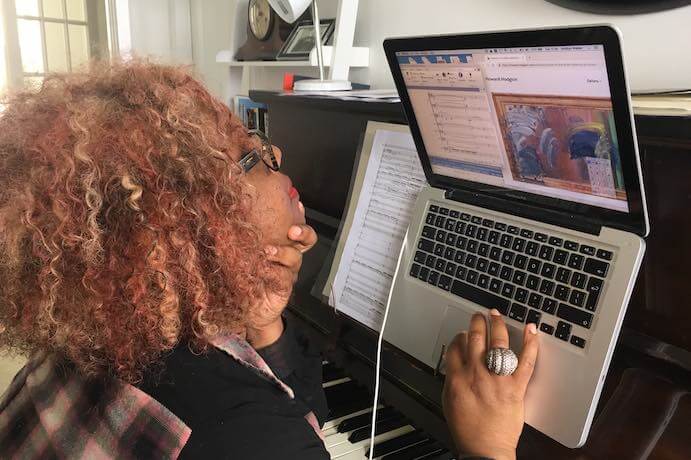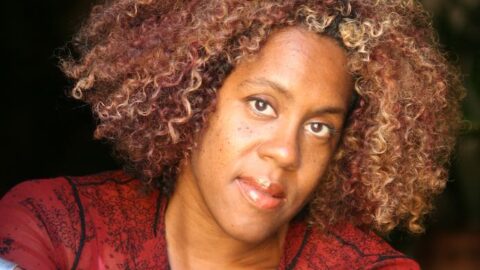Equally recognized as a singer-songwriter and a contemporary classical composer, Errollyn Wallen is a peerless figure in British music. Her list of compositions stretches back four decades and includes numerous operas (17 to date, including the multi-opera Another America, “an exploration into the black condition, past, present and future”), orchestral, choral and chamber works, concertos, extensive repertoire for solo piano and solo voice, as well as award-winning scores for visual media. Her music was featured in the opening ceremony of the London 2012 Paralympic Games. There is a songbook in her name.
Born in Belize and raised in London, she studied at the universities of London and Cambridge and founded Ensemble X, whose motto is, “We don’t break down barriers in music… we don’t see any.” Her list of collaborators is vast, and ranges from institutions like the Welsh National Opera and Chineke! to Dunedin Consort and the Tallis Scholars. She has co-written a song with Canadian astronaut Steve McLean while he was in orbit aboard Space Shuttle Atlantis, and she made a film entitled FALLING about McLean’s space mission for Channel 4. She has released several CDs of her songs, and appears on the Brodsky Quartet’s Mood Swings album alongside Björk, Sting, Elvis Costello and Meredith Monk. She was awarded an MBE for her services to music in 2007, won the Ivor Novello Award for Classical Music in 2013 and was listed in BBC 100 Women 2018.
On August 15, 2019, her new orchestral work This Frame Is Part of the Painting, a homage to the painter Howard Hodgkin, will be premiered at BBC Proms at the Royal Albert Hall, performed by the BBC National Orchestra of Wales and mezzo-soprano Catriona Morison.
Can you discuss the process of creating THIS FRAME IS PART OF THE PAINTING, from finding inspiration and material for the work to devising a part for voice?
The title of my work, THIS FRAME IS PART OF THE PAINTING, comes from a stamp in Howard Hodgkin’s studio.
As I say in my programme note, inspiration can come from anywhere—the sound of traffic, a washing machine, the sea… or, as is most often the case, simply the notes already there, waiting for me on the piano. But from the moment I saw the stamp marked ‘THIS FRAME IS PART OF THE PAINTING’ on a table in Howard Hodgkin’s studio in 2015, I was intrigued. I little knew then that these words (being a terse reminder to art galleries to refrain from removing the intentionally painted-over frame) would one day provide the title of deeply personal musical work written in homage to a great British painter who lived from 1932 to 2017.
When I first came across Hodgkin’s paintings, I was instantly knocked sideways by their emotional force, conveyed through a superior technical mastery of colour, shape and form.

Your compositional language is direct and yet so incredibly varied, incorporating elements from across different periods, genres, and geographies. Can you talk about some of the precursors that may have echoes in or influences upon your music and text?
For me, composition is where I can be most free. Through composing, I can most fully contemplate the principles of music which remain constant across all cultures and across all time. In the last section of THIS FRAME IS PART OF THE PAINTING, I quote from Byrd’s “Kyrie” from his Mass for Four Voices and a classical Indian raag, over which I weave other contrapuntal textures using the solo voice and the orchestra.
What is job number one for you in setting out to compose a new piece?
To find the truth. A new composition always poses a question, whether that be technical or philosophical.
The challenge for me is to find answers and sometimes this leads to using new techniques to do so.
Of course these answers beget further questions—and a new idea for another work!
How did your lighthouse in Scotland come about? The idea that you compose in such a setting seems magical and also badass.
I needed to find a place that was by the sea, remote and absolutely quiet. That’s how I found my lighthouse! I can actually compose anywhere, but to work in such a place of staggering beauty has made such a difference to my life.

Your success cannot but help to be an inspiration to others, especially younger artists. Yet, it must also result in situations where you are dealing with issues of representation in a way that takes away energy from just doing the work. Can you share any insights or strategies you’ve developed to keep focused and move forward as a creator?
As I said earlier, it is important to me to feel free. Music and the making of music belongs to everyone. Talent isn’t about class or wealth.
From a young age, I learned to block out the negative comments coming my way and I kept the realisation of my dreams of a life in music as the ultimate goal. The journey hasn’t been easy, but I have had no other choice but to be a composer. I believe that to stay sane, one must stay close to the music, to the source. There is always so much more to learn.
There are so many more stories to tell and so many more voices to hear from; major developments and revitalisation in Western art has always been brought about by the impact and influence of other cultures.
























